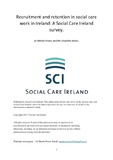| dc.description.abstract | As the first decade of the new millennium drew to a close, concerns were raised
around the “dramatic growth in Higher Education social care programme providers since
2002” and the conclusion was reached that social care work could not “possibly absorb” the
number of graduates annually and that this situation was thus “unsustainable” (Lalor, 2009,
p. 1). It might seem almost ironic then that by the end of the second decade of the new
millennium there were rumblings of recruitment and retention challenges within social care
work. Certainly, TUSLA the child and family agency experienced substantial difficulties in this
regard. In the period between 2015 and 2019 for example, TUSLA experienced a 30% increase
in referrals, but only a 1% increase in the social care workforce, with agency workers being
increasingly utilised to bolster service provision (Clarke & McMahon, 2020). In the allied
profession of social work, similar problems were experienced and much of the explanation
for the recruitment and retention challenges in securing social workers focused on a limited
graduate pool and immigration challenges (Clarke & McMahon, 2020).
If the “dramatic growth” in social care graduates can be taken to suggest strongly that
shortages in supply due to a limited pool to recruit from was unlikely to be a constraining
factor in social care, then explanations for issues surrounding recruitment and retention must
be sought elsewhere. This is not to suggest that supply side considerations do not
undoubtable play some part. Indeed, recruitment and retention of workers in social services
has been highlighted as a concern throughout the EU (Lethbridge, 2017) and in Ireland the
austerity period was especially challenging for the health and social care sector. A
combination of funding cuts, embargos and moratoriums on recruitment, as well as demands
for work practice changes and increased privatisation through contracting out meant that
there were often combined pressures of increasing unemployment or underemployment, and
a deterioration in conditions of employment (Cantwell & Power, 2016; Dukelow & Kennet,
2018; Mahon, 2016; Murphy, 2017). Unsurprisingly therefore in the austerity era the tap of
emigration turned on once again and educated young people left in droves (Gilmartin, 2017;
Glynn et al., 2013). Nonetheless, with Ireland rebounding out of the Great Recession in the
later period of the 2010s and the labour marketing tightening, CORU noted in 2019 that there
were 14 educational providers providing some 34 social care programmes/pathways into
social care work. As such, supply had clearly not diminished in the intervening period and any
explanation for recruitment and retention concerns must therefore to be located on the
demand side of the equation (Kennedy & Kennedy-Burke, 2018; CORU, 2019).
If there was a “dramatic growth” is supply at the turn of the millennium there has
arguably been a similar, though less extensive, growth in demand over the last two decades.
Certainly, social care work has expanded beyond the traditional arenas of residential care for
children and individuals with disabilities and social care work now takes place in an increasing
diverse range of services, including addiction, homelessness and migrant services to name
but a few (Byrne, 2016; McGarr & Fingleton, 2020; Mulkeen, 2020). At the same time, it must
be acknowledged that recruitment and retention to any field are impacted by wider factors.
Affordable childcare for example, remains a particular challenge in Ireland, especially where
there are irregular work patterns and unsociable hours (Murphy, 2017; Russel et al., 2018).
Given that both are features of social care work and that the social care workforce is
overwhelmingly female, such influences cannot but impact recruitment and retention. In a
similar fashion, upwardly spiralling rents and house prices and cost of living increases, as well
as inflationary pressures often fanned the flames of industrial unrest, especially in the health
and social care sectors (Lyons, 2021; McQuinn, 2017). In 2019 for instance, nurses, healthcare
workers and support staff all took to the picket lines in disputes over pay and conditions, and
concerns around recruitment and retention (Miley, 2019a & b; Wall, 2019).
Against this backdrop, and with concerns emerging of a potentially looming
recruitment and retention crisis in social care work, Social Care Ireland undertook this study
to examine work patterns, the extent to which there was a practice of offering lower grade
pay and conditions in recruitment, and, most importantly, what social care workers
themselves viewed as the ‘greatest challenges in recruiting and retaining social care workers’. | en_IE |


